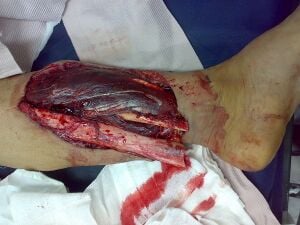
Objective:
In this Module, you will learn core knowledge and competencies needed to diagnose, evaluate, and manage open fractures.
By the end of this Module, you will be able to:
- Understand basic knowledge related to open fractures, including correct terminology, anatomy, and pathophysiology
- Gain confidence in your ability to correctly diagnose, evaluate, and classify open fractures.
- Understand the basics of open fracture management including theoretical principles of soft tissue management, irrigation and debridement, and safe external fixator placement.
- Understand how to provide post-operative care for open fractures, including addressing any complications that may arise.
What are Open Fractures?[edit | edit source]
Open fractures are fractures with direct communication to the external environment. Diagnosis is made clinically by assessing the size and nature of the external wound as well as obtaining radiographs of the bone at the location of the soft tissue injury. Treatment depends on location of fracture but generally requires immediate IV antibiotics and urgent irrigation and debridement followed by surgical fixation open reduction and internal fixation (ORIF) or open reduction and external fixation (OREF) as needed.
You will use this rubric to assess your own knowledge and skills and to measure your progress over time as you learn more about diagnosing, classifying, and managing open fractures.
Assessment Rubric for Learning Target 2: I have the basic knowledge required to confidently diagnose and manage open fractures.[edit | edit source]
| SKILLS: | EMERGING
(I am just getting started on this skill) |
APPROACHING
(I am still developing this skill) |
MEETS
(I am competent and confident in this skill) |
|---|---|---|---|
| 1. Understand basic knowledge (terminology, anatomy, and pathophysiology) related to open fractures | I am starting to learn basic knowledge about open fractures. | I understand most basic knowledge about open fractures. | I am confident in my basic knowledge about open fractures. |
| 2. Diagnose and classify an open fracture | I am starting to learn to diagnose and classify open fractures. | I can reliably diagnose open fractures, but I do not always classify them correctly. | I am confident in my ability to correctly diagnose, evaluate, and classify open fractures. |
| 3. Manage an open fracture (including understanding theoretical principles of soft tissue management, irrigation and debridement, and safe external fixator placement) | I am starting to learn basic concepts of managing open fractures. | I can reliably manage an open fracture, including understanding principles of soft tissue management, irrigation and debridement, and external fixator placement. | I can correctly and consistently prepare a treatment plan based on findings to care for a patient's open fracture. |
| 4. Provide post-operative care | I am able to provide basic instructions for nursing staff and patient/family for post-operative care. | I am able to monitor for and identify post-operative complications. | I am able to address complications that may arise from injury/treatment. |
- Buckley R, Colton C, Camuso M. Principles of management of open fractures. AO Surgery https://surgeryreference.aofoundation.org/orthopedic-trauma/adult-trauma/tibial-shaft/further-reading/principles-of-management-of-open-fractures
- Gustilo RB, Merkow RL, Templeman D. The Management of Open Fractures, The Journal of Bone and Jone Surgery: Feb 1990 - Volume 72 - Issue 2, p. 299-304 https://pubmed-ncbi-nlm-nih-gov.ucsf.idm.oclc.org/2406275/
- https://www.orthobullets.com/trauma/1004/open-fractures-management
- Zalavras CG, Patzakis MJ. Open Fractures: Evaluation and Management. JAAOS - J Am Acad Orthop Surg. 2003;11(3). https://pubmed.ncbi.nlm.nih.gov/12828451/
- Zalavras CG, Marcus RE, Levin LS, Patzakis MJ. Management of Open Fractures and Subsequent Complications. JBJS. 2007;89(4).https://pubmed.ncbi.nlm.nih.gov/17432452/
- https://www.aofoundation.org/-/media/project/aocmf/aof/documents/icrc/content-by-chapter/a-field-guide_chapter-08.pdf
Click on the video to the right "ETALO Open Fracture Basics Instructional Video". This goes over the basics of open fractures including definition, classification, initial treatment and temporary stabilization.
Refer to the rubric in Step 3 (you may want to print out one or more copies). Use the rubric to assess the following and note if you are EMERGING, APPROACHING, or MEETING each of the sub-skills. This will help you know which knowledge and sub-skills require more review. Please take notes on your self-assessment below.
- Row 1: How confident are you in your basic knowledge about open fractures?
- Row 2: How confident are you in your ability to consistently and correctly diagnose, evaluate, and classify open fractures?
- Row 3: How confident are you in your ability to correctly and consistently manage a patient's open fracture and prepare a treatment plan?
- Row 4: How confident are you in your ability to provide post-operative care, including identifying and managing any treatment complications?
Self-assessment notes[edit | edit source]
Once you have determined that you MEET all of the sub-skills, you can move on to the next Module.
